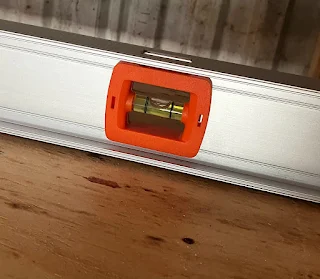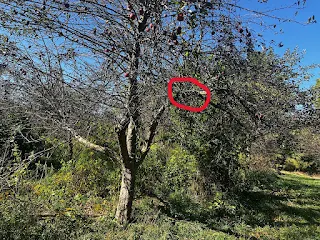 |
| 64 square-feet of shelving space. |
 |
| The shelves are level. The stringers in the pole barn are not. They slope about 2" in 8 feet. |
 | |
| The platform without decking. |
In a nutshell, deer eat tender, young shoots that are less than 6' above the ground. If the highest apples that can be hand picked are (8' (step ladder) +7' (reach) - 2' (not standing on two top steps)) then all of the apples must be carried between 6' and 13' of height. Since horizontal limbs generally slope upward as they grow away from the trunk, it is hard to create a "cone" shaped tree that ensures even light distribution throughout the tree's crown. More typically, one ends up with a mushroom shaped tree or a "flat-topped" tree.
It isn't just the deer pushing the growth higher. If the orchard floor is maintained by mowing, then any limbs that extend beyond the mulched-or-herbicide rows must be high enough to not injure people operating mowing equipment.
Commercial orchards are mostly tall-spindles. Basically, a wall or a comb with the teeth pointing upward. That comes at a price of 1000 trees per acre vs. 115 for trees planted 15' by 25'. At $20 a tree, that is a very stiff toll. Additionally, small trees have smaller roots and cannot access moisture stored in the subsoil nearly as efficiently as larger trees. Those tall-spindle hedges require irrigation.
 |
| Another "typical" tree. Too much wood carried too far away from the trunk and too high in the air. |
The "plan" is to ATTEMPT squatty cones (modified, central-leaders or Christmas-tree shape) with a maximum height of 10' on the central leader and a maximum crown diameter of 16'. Why 10'? because apples will be carried on the new growth that will be ABOVE the 10' heading cut to the central-leader.
A secondary factor pushing me into aggressive pruning is the young trees that will be plugged into the holes left by culled or dead trees. Those young trees will fail if they do not get sunshine. That means that the survivors must be pruned back into their allotted space.


That's a rough looking bunch of trees. It's going to take a few years to get that right. I'd trim them back hard and fine tune as they grew back out. ---ken.
ReplyDeleteNice carpentry work. Roger
ReplyDeleteThe platform is a really good idea, but it really needs some form of guardrail, to prevent you taking one step too many backwards. Your choice, but the ground can be awful hard when you arrive there.
ReplyDeleteThe platform is looking good but the setup required for a limited work space seems excessive. I take it you never had battery powered pole chainsaw? I scoffed at them, until a friend got one. Then I borrowed it! People with travel trailers sometimes carry them to cut low hanging branches where they want to park.
ReplyDeleteAnd where will you run when you are on a platform and a cut branch swings your way? I know that never happens, but is there an escape plan?
sam